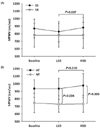Abstract
BACKGROUND/OBJECTIVES
SUBJECTS/METHODS
RESULTS
Figures and Tables
 | Fig. 1Heart-femoral pulse wave velocity (hfPWV) values at baseline, after 7 days of the low sodium DASH diet (LSD), and after 7 days of a high sodium DASH diet (HSD).(A) No difference in hfPWV values was observed between sodium sensitive (SS) and sodium resistant (SR) individuals after adjusting for age, gender, body mass index (BMI), mean arterial pressure (MAP), fasting blood glucose level, and total cholesterol level (analysis of covariance P > 0.05). Individuals with SS showed a higher value of hfPWV after 7 days of the HSD compared to that after 7 days of the LSD, both in the unadjusted (paired t-test P = 0.001) and adjusted analysis (one-way repeated measures analysis of variance adjusted with change of MAP P = 0.037). (B) Hypertensive individuals (HT) had a higher hfPWV value than normotensive individuals (NT) after 7 days of the LSD and HSD in adjusted analysis for confounders (analysis of covariance P = 0.034 and 0.006, respectively). HT showed a higher value of hfPWV after 7 days of the HSD than after 7 days of the LSD upon unadjusted analysis (paired t-test P = 0.046), but not adjusted analysis (one-way repeated measures analysis of variance adjusted with change of MAP P = 0.210). The difference in hfPWV values between groups was analyzed by analysis of covariance, adjusted with age, gender, BMI, heart rate, MAP obtained simultaneously during the measurement of hfPWV, fasting blood glucose, and total cholesterol. The change in hfPWV from LSD to HSD was analyzed by one-way repeated-measures analysis of variance adjusted with the change of MAP, which was obtained simultaneously during measurement of hfPWV.
|
 | Fig. 2Percent changes in heart-femoral pulse wave velocity (hfPWV) in each group.The percent change in sodium sensitive individuals (SS) was higher than that in sodium resistant individuals (SR). No significant difference in the percent change in hfPWV was observed between hypertensive (HT) and normotensive individuals (NT). The percentchangesin hfPWV between groups (SS vs. SR, and HT vs. NT) were compared by analysis of covariance using age, gender, body mass index, mean arterial pressure, fasting blood glucose level, and total cholesterol level as covariates.
|
Table 1
Baseline characteristics of the study participants.

Data are the means ± SD. Mean blood pressure was measured simultaneously with pulse wave velocity. SS, individuals with sodium sensitivity; SR, individuals with sodium resistance; HT, individuals with hypertension; NT, individuals with normotension; SS-HT, individuals with sodium sensitivity and hypertension; SS-NT, individuals with sodium sensitivity and normotension; SR-HT, individuals with sodium resistance and hypertension; SR-NT, individuals with sodium resistance and normotension. Pearson's chi-squaretest or the independent t-test were performed for the categorical data or continuous data, as appropriate.
Table 2
Changes in heart-femoral pulse wave velocity among four subgroups divided by the status of hypertension and sodium sensitivity.

Data are the means ± SD. Different letters represent statistically significant differences in the adjusted mixed effect model for repeated measurements. †Unadjusted p-values were obtained using one-way repeated ANOVA for each group. ‡Unadjusted p-values were obtained using two-way repeated ANOVA for all groups. §Adjusted p-values were obtained using the mixed effect model for repeated measurements under control of a time-varying covariate (mean arterial pressure) and time-invariant covariates (age, sex, body mass index, fasting blood glucose, and total cholesterol). hfPWV, heart-femoral pulse wave velocity; LSD, low sodium DASH diet; HSD, high sodium DASH diet; SS-HT, individuals with sodium sensitivity and hypertension; SS-NT, individuals with sodium sensitivity and normotension; SR-HT, individuals with sodium resistance and hypertension; SR-NT, individuals with sodium resistance and normotension.




 PDF
PDF ePub
ePub Citation
Citation Print
Print


 XML Download
XML Download